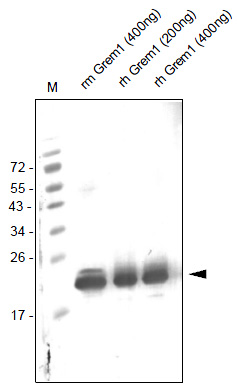Gremlin 1 (GREM1) Rabbit Polyclonal Antibody
Other products for "Gremlin 1"
Specifications
| Product Data | |
| Applications | WB |
| Recommended Dilution | Western blot: 2-5 μg/ml. |
| Reactivities | Human |
| Host | Rabbit |
| Isotype | IgG |
| Clonality | Polyclonal |
| Immunogen | Highly pure (> 95%) recombinant Human Gremlin-1 (Lys25-Asp184) derived from E. coli (Cat.-No AR26007PU-N). |
| Specificity | This antibody detects Human Gremlin-1 / GREM1. Other species not tested. |
| Formulation | PBS, pH 7.2 State: Purified State: Lyophilized purified Ig fraction |
| Reconstitution Method | Centrifuge vial prior to opening. Restore in sterile water to a concentration of 0.1-1.0 mg/ml. |
| Purification | Protein A Chromatography |
| Conjugation | Unconjugated |
| Storage | Prior to reconstitution store at 2-8°C. |
| Stability | Shelf life: one year from despatch. |
| Gene Name | gremlin 1, DAN family BMP antagonist |
| Database Link | |
| Background | Gremlin, also known as “Increased in High Glucose protein 2” (IHG2) and “Down regulated in Mos-transformed cells protein” (Drm), is a 28 kDa member of the Dan family of secreted glycoproteins. Native human Gremlin consist of 160 amino acids. The mature region contains one potential site for N-linked glycosylation (Asn42), a cysteine-rich region, and a cysteine-knot motif (aa94-184) whose structure is shared by members of the TGFβ superfamily. Posttranslational modifications include glycosylation and phosphorylation (1-3). Human Gremlin exists in both secreted and membrane-associated forms (3) and there exist 2 isoforms. The aa sequence identity of human Gremlin with mouse and chicken Gremlin is 99% and 86%, respectively. Northern blot analysis shows that Gremlin mRNA is highly expressed in the small intestine, fetal brain and colon, and weakly expressed in adult brain, ovary, prostate, pancreas and skeletal muscle (4). Gremlin functions as a bone morphogenetic protein (BMP) antagonist. It acts by binding to, and forming heterodimers with, BMP2, BMP4, and BMP7, thus preventing them from interacting with their cell surface receptors (1). This mechanism is thought to be responsible for the pattern-inducing activity of Gremlin during embryonic development (5) and to play a role in human diseases, such as diabetic nephropathy (6). However, intracellular BMP-independent mechanisms of action (7) may mediate the ability of Gremlin to suppress transformation and tumor genesis under certain experimental conditions (8, 9). Gremlin also interacts with Slit proteins and acts as an inhibitor of monocyte chemotaxis (10). In addition, Gremlin has been found to be a proangiogenic factor expressed by endothelium (9). Furthermore Gremlin is a novel agonist of the major proangiogenic receptor VEGFR2 (11). |
| Synonyms | DAND2, CKTSF1B1, DRM, PIG2, IHG-2, GREM-1 |
| Reference Data | |
| Protein Families | ES Cell Differentiation/IPS, Secreted Protein |
Documents
| Product Manuals |
| FAQs |
| SDS |
{0} Product Review(s)
0 Product Review(s)
Submit review
Be the first one to submit a review
Product Citations
*Delivery time may vary from web posted schedule. Occasional delays may occur due to unforeseen
complexities in the preparation of your product. International customers may expect an additional 1-2 weeks
in shipping.






























































































































































































































































 Germany
Germany
 Japan
Japan
 United Kingdom
United Kingdom
 China
China



